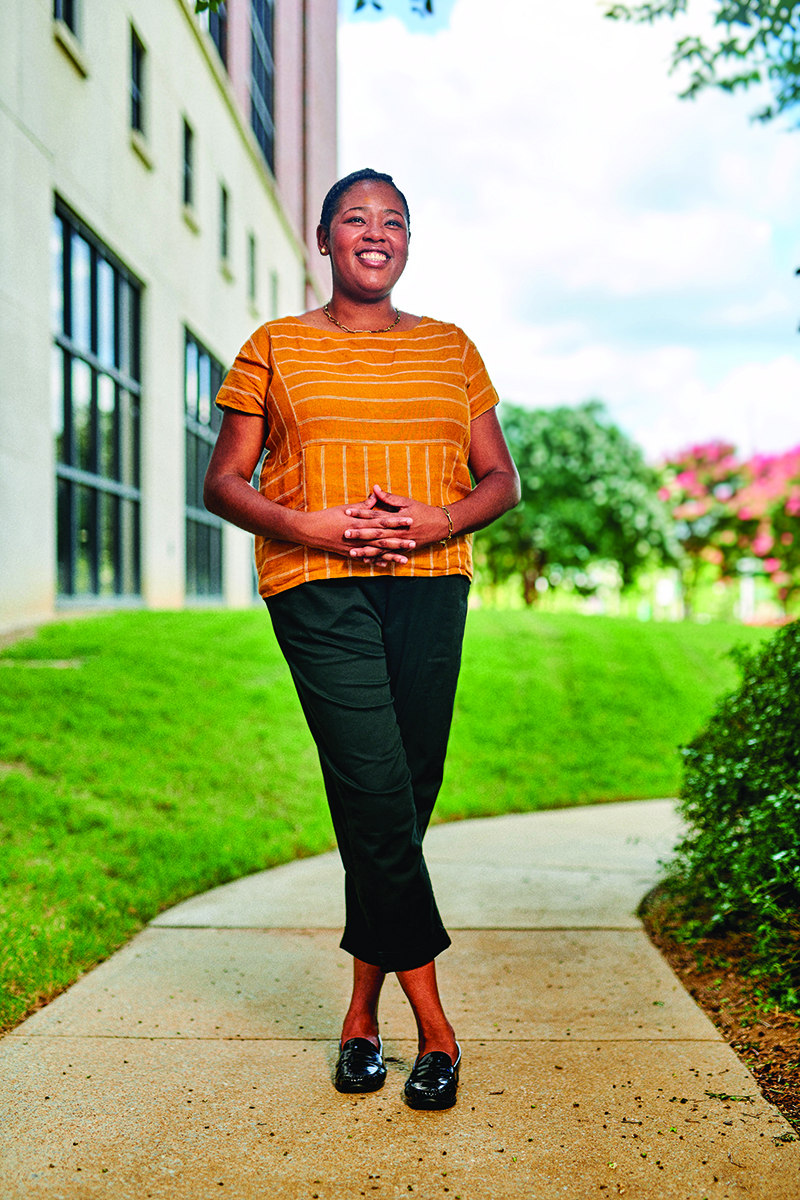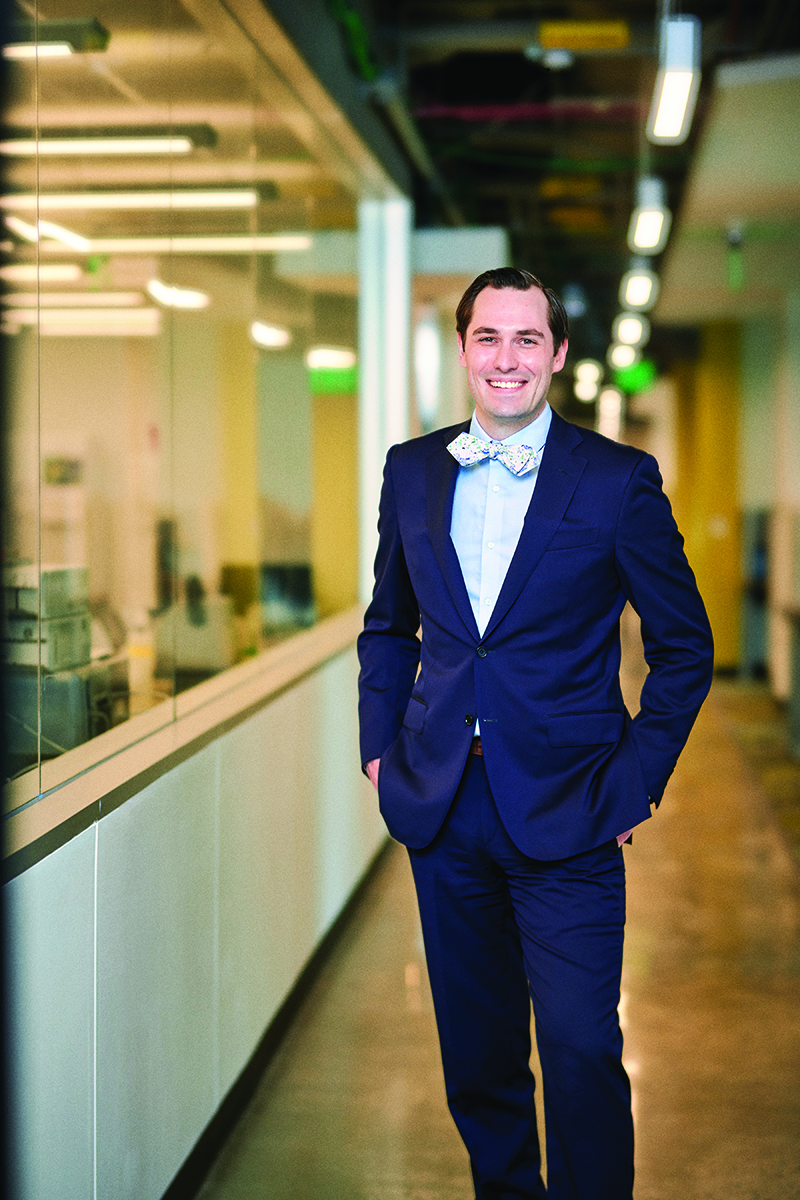Alana Jones, a Medical Scientist Training Program (MSTP) M.D.-Ph.D. student at the UAB Heersink School of Medicine, was a Latin and biology double-major as an undergraduate at Howard University—unwavering, almost, in her plans to become a physician.
Then one summer she came to UAB for an NIH-funded program called PARAdiGM, which accepts outstanding college students from underrepresented minority backgrounds and introduces them to the concept of a career as a physician-scientist, a unique path for those who want to pursue both research and clinical medicine.
Jones spent the summer doing lab research in neonatology while also shadowing a physician in the neonatology ward. “I got to see how the wet lab and the clinic really merge, and I loved being able to go back and forth,” she says. After returning to the program the following summer, she decided she wanted to pursue both worlds as an M.D.-Ph.D., a medical scientist with both a medical degree and a Ph.D. She is currently working on her Ph.D. dissertation project developing genetic and epigenetic risk scores for kidney disease in African Americans—something that combines her interests in health equity, epidemiology, and genetics—under the guidance of Marguerite “Ryan” Irvin, Ph.D., in the UAB School of Public Health.
 Alana Jones
Alana Jones
What It Takes
The MSTP is a rigorous process for those who undertake it, beginning with two years taking a selection of medical school and graduate courses concurrently, followed by completion of their Ph.D. before finishing clinical training in medical school. Completing the MSTP normally takes about eight years.
The Heersink School of Medicine’s M.D.-Ph.D. program dates back to 1987, and the National Institutes of Health (NIH) designated the program as an MSTP in 1991. The designation confers prestige by recognizing the strength of an institution’s M.D.-Ph.D. program after an exhaustive review process.
No less importantly, it provides funding to pay for MSTP students’ tuition, fees, and stipends, along with support for curriculum development programming. UAB’s MSTP, which recently celebrated its 30th anniversary, has produced leaders in science and medicine who have landed at some of the most prestigious institutions around the country. Roughly two-thirds of MSTP graduates move on to top 25 residency programs. Many others have remained at or returned to UAB and now serve as faculty, and others hold leadership positions in the school.
MSTP Director Talene Yacoubian, M.D., Ph.D., professor of Neurology, explains the value of a strong M.D.-Ph.D. program for fostering medical scientists who have the skills to play a singular role in medicine. “M.D.-Ph.D.s bridge the gap between laboratory research and clinical practice,” she says. “Physician-scientists understand the clinical realm and know where we still lack knowledge in disease and what therapies we still need, so their research is dedicated to solving those questions and problems that ultimately improve care for patients. Being able to bridge both fields is where an M.D.-Ph.D. fills a unique spot in academics and research in general.”
Alison Gammie, Ph.D., director of Training, Workforce Development, and Diversity at the National Institute of General Medical Sciences (NIGMS)—the institute that oversees the nation’s NIH-funded MSTPs—cites the value of strengthening the relationship between research and clinical practice as the reason the NIH supports MSTPs at UAB and other chosen institutions.
“With the dual qualification of rigorous scientific research and clinical practice, graduates are equipped with the skills to develop research programs that accelerate the translation of research advances to the understanding, detection, treatment, and prevention of human disease,” Gammie says.
Attracting Top Talent
William Geisler, M.D., MPH, professor of Medicine, is the assistant dean for Physician Scientist Development in the Heersink School of Medicine and former co-director of the MSTP. “What the NIH MSTP designation means is we’re in the top echelon of M.D.-Ph.D. programs,” he says. “And because we’re in that top group, we can attract top talent. There are much more rigorous standards you’re held to as an MSTP—we have to be innovative, we have to change with the times and strive to be at the forefront.”
As an indication of the program’s success, Geisler points to the fact that, in the most recent renewal of their NIH-funded training grant, the UAB MSTP was awarded additional funds to support acceptance of two more students per year into the program. There are currently 75 students in various stages of the program at the Heersink School of Medicine.
Randy Seay, M.A., MPA, MPH, associate director of the Physician Scientist Development Office, says another selling point for potential applicants is the fact that UAB has so many strong, nationally recognized programs in multiple fields of medical research. “The overarching research opportunities, from epidemiology to nephrology, are what draw students here,” Seay says. “They like that they have different opportunities aside from the traditional mold of biomedical science. They can take alternate pathways like health behavior, rehabilitation sciences, vision sciences, epidemiology, and biomedical engineering. Those alternate pathways to get a Ph.D. create a much broader applicant pool for the UAB MSTP. That is a great strength from an institutional standpoint.”
Faculty members and mentors emphasize that, with the level of commitment required to complete an MSTP, the school places a high priority on providing support across the board for students. This begins with a strong mentorship program. Jeremy Day, Ph.D., an associate professor in the Department of Neurobiology, says he values the opportunity to mentor MSTP students along with the other Ph.D. students in his lab as a way of giving back what was given to him as a Ph.D. candidate. “I received training as a graduate student and post-doctoral fellow in how to do science—how to set up a research experiment, collect data, analyze that data, translate the findings, and communicate them in the format of a publication,” Day says. “I really care about passing that on to the next generation of trainees coming through the lab.” He says he also appreciates what the MSTP students in turn bring to the lab. “They want to think about how the work they’re doing affects patients—how it’s going to translate. I think that’s good for everyone.”
Peer support also plays an important role, says Seay. “One of the advantages of our program is we have a built-in support system. When we recruit students, we make sure they meet with students who fit in some way their own life situation. There are students who are establishing relationships, who are having children, trying to find work-life balance, focusing on trying to complete the degree and maintaining some type of personal environment. Peer connections can help them get through the rigors of the day-to-day but also year one to year eight.”
Yacoubian points to the ways the program has grown over the years as well as goals on the horizon. The program boasts a high level of diversity both in gender ratios and enrollment of those traditionally underrepresented in medicine. The program has expanded on its training for grant writing, which culminates in every student submitting a fellowship grant—many of them with favorable results. “We have a high rate of students who are successful in getting funding, which is great for them because it will help them in the long run in their career goals,” Yacoubian says. “But it also helps our program by bringing in money to our program, so it’s a win-win for everyone.” Also on the horizon is an alumni networking program to pair current students with alumni across the country who can share advice and serve as mentors.
 Corey Duke
Corey Duke
Corey Duke, a recent MSTP graduate who began his residency in child neurology this summer at Boston Children’s Hospital—where he has already connected with a fellow UAB MSTP alum, Christopher Yuskaitis, M.D., Ph.D., to serve as a mentor for this next stage of his career—says he’s helped to spread the word by speaking to undergraduate students about what it means to be an MSTP. “I tell them, if you’re curious, if you’re passionate, and you get a lot of joy out of helping the patient in front of you—but you know you won’t be fully satisfied without having the lab research skills as well— then it’s the right path for you.” He adds that he advocates for UAB’s program above all others for the level of mentorship it provides, the volume and broad variety of patients students are exposed to, and research he says is on par with that of any major institution.
“If you’re not afraid of challenge, UAB is a wonderful place to be,” Duke says. “It’s a privilege to get to see the patient diversity and to help UAB with its mission to serve people. The opportunities here are incredible, and the MSTP can make you into the person who’s helping push the boundaries of medicine with what you discover in science.” – Rosalind Fournier